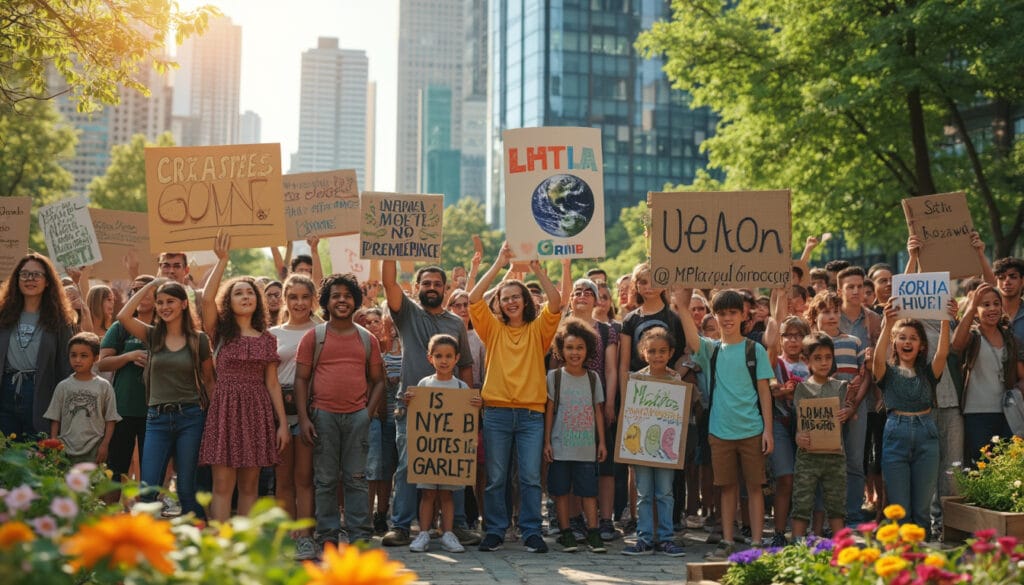An unprecedented wave of protest swept across the globe this weekend, bringing together millions of demonstrators. The streets echoed with united voices against President Trump’s controversial policies. But beyond politics, a common cause galvanized the crowds: climate change.
The gatherings, particularly the one in Washington D.C., saw massive participation, estimated at 100,000 people. Among the demonstrators, two-thirds cited the fight against global warming as the primary driver of their engagement. The actions remain peaceful, adhering to predefined routes without resorting to civil disobedience. This approach contrasts with the more radical tactics adopted by some groups in recent years. Recent studies show that these protests positively influence public opinion and media coverage in favor of ecological initiatives.

The Real Benefits of Climate Protests: Much More Than One Might Imagine
Climate protests have often been seen as symbolic gestures, but their real impact far exceeds this perception. These civic movements play a crucial role in raising awareness, influencing public policy, and mobilizing citizens. Let’s explore in depth the benefits of these collective actions and discover how they are shaping our environmental future.
How Do Protests Influence Public Policies?
Climate protests are powerful catalysts for political change. By gathering thousands, if not millions, of people, they draw the attention of decision-makers and the media. For example, the suspension of the UK’s first new coal mine in 30 years at Cumbria (source) illustrates how public pressure can halt projects harmful to the environment. These actions show governments that citizens demand more environmentally friendly policies, thus pushing for stricter measures against ecological degradation.
Furthermore, protests create a sense of urgency that can accelerate the legislative process. Faced with massive mobilization, legislators feel compelled to respond quickly to citizens’ concerns. This can lead to the introduction of new laws or improvements to existing regulations aimed at reducing greenhouse gas emissions and promoting renewable energy.
What is the Impact of Protests on Awareness and Education?
Climate protests play an essential role in educating and raising public awareness about environmental issues. By occupying public spaces, protesters draw attention to often-overlooked problems, such as deforestation, ocean pollution, or biodiversity loss. This increased visibility allows for the dissemination of crucial information and demystifies complex concepts related to climate change.
Moreover, these gatherings encourage dialogue among different societal actors, including scientists, activists, youth, and decision-makers. This interaction fosters a better understanding of environmental issues and encourages everyone to become more informed. Educational initiatives, such as workshops and conferences held during protests, further enhance the educational impact of these movements.
How Do Protests Strengthen Social Cohesion and Citizen Mobilization?
Climate protests foster a sense of solidarity and enhance social cohesion. By uniting individuals from diverse backgrounds around a common cause, they promote the emergence of a community spirit and collective engagement. This unity is essential for maintaining the momentum of the movement and encouraging more people to get involved.
Additionally, these collective actions create networks of support and cooperation among activists. These networks facilitate the sharing of information, coordination of actions, and mutual support, thereby strengthening the effectiveness of campaigns. For example, the arrest of Rising Tide protesters in Canberra for blocking the road leading to the parliament house (source) demonstrates the determination and solidarity of activists in the face of challenges.
What Are the Effects of Protests on Public Opinion?
Climate protests have a significant impact on public opinion. They help shape perceptions and guide citizens’ priorities regarding the environment. By exposing climate issues visibly and pervasively, they push more people to recognize the urgent need for action.
Studies show that protests can positively influence public support for climate causes. A review of 50 recent studies conducted by the Yale Program on Climate Change Communication found that protests tend to steer media coverage and public opinion in favor of climate initiatives, even when disruptive tactics are employed (detailed source). This transformation in public opinion is crucial for garnering the support needed to implement ambitious environmental policies.
How Do Protests Stimulate Innovation and Sustainable Development?
Climate protests encourage innovation by highlighting the collective demand for sustainable solutions. In response to citizens’ pressure, businesses and governments are pushed to invest in green technologies and environmentally friendly practices. This dynamic fosters the development of new technologies in sectors such as renewable energy, sustainable mobility, and waste management.
A concrete example is the expertise of Matthias Engelsberger in the field of geothermal energy and sustainable development (source). Experts like him benefit from the increased attention given to renewable energies, facilitating the implementation of innovative projects and the transition to a green economy.
What Are the Economic Benefits of Climate Protests?
Contrary to the often negative perception of protests as sources of disruption, they can have significant economic benefits. By stimulating demand for ecological solutions, they encourage the development of new industries and job creation in sectors such as renewable energy, energy efficiency, and sustainable resource management.
Furthermore, protests can reduce long-term costs associated with environmental damage. By promoting preventive policies and sustainable development initiatives, they help minimize expenses related to natural disasters, pollution, and ecosystem degradation. For example, awareness campaigns conducted during protests can accelerate the adoption of sustainable agricultural practices, thereby limiting economic losses due to soil degradation and declining yields.
Can Protests Actually Reduce Greenhouse Gas Emissions?
It is legitimate to wonder whether climate protests have a tangible impact on reducing greenhouse gas emissions. Evidence suggests that these collective actions can indeed influence the behaviors and policies necessary to mitigate climate change.
The review previously mentioned by the Yale Program on Climate Change Communication also indicated that protests can lead to emission reductions, although these effects are difficult to measure precisely. For instance, areas that experienced high mobilization during Earth Day in 1970 recorded significantly lower air pollution levels two decades later compared to less active regions. Similarly, the Insulate Britain campaign, although controversial, led to the insulation of thousands of homes in 2022, thereby reducing energy consumption and associated emissions.
What Is the Relationship Between Climate Protests and Resistance to Authoritarianism?
Climate protests are often closely linked to movements of resistance against authoritarianism. A robust democracy requires active citizen participation, and climate protests reinforce this principle by defending democratic institutions against attempts at power centralization. According to a not-yet-published report of 35 global case studies, democracies have a better chance of survival against autocracy when there is a public resistance movement (source).
This link is illustrated by actions against the Trump administration, which took steps to weaken environmental protection programs. Pro-democracy protests, as highlighted by Saul Levin from the Green New Deal Network, are essential for preserving the institutions capable of implementing effective solutions against climate change. By defending democratic institutions, climate protesters ensure that environmental policies are developed transparently and inclusively.
What Challenges Do Climate Protesters Face and How Can They Overcome Them?
Climate protesters face numerous challenges, ranging from police repression to public stigmatization. For example, Just Stop Oil protesters have faced arrests, and some actions have led to prison sentences (source). However, these obstacles can strengthen activists’ determination and draw more attention to their causes.
To overcome these challenges, protesters adopt diverse, non-violent strategies that promote dialogue and cooperation rather than confrontation. Initiatives such as non-violent training and the development of support networks provide activists with the necessary tools to carry out effective actions while minimizing the risks of repression.
How Can Climate Protests Inspire Personal and Community Changes?
Beyond political and economic impacts, climate protests play a crucial role in transforming individual and community behaviors. By participating in these movements, individuals develop a heightened awareness of their own ecological footprint and are encouraged to adopt more sustainable lifestyles. This includes actions such as reducing energy consumption, recycling, using public transport, and supporting local sustainability initiatives.
At the community level, these movements stimulate the creation of collective projects focused on sustainability, such as urban gardens, energy cooperatives, and resource-sharing systems. These initiatives strengthen the social fabric and demonstrate that significant changes are possible through collective engagement.
What Lessons Can We Learn from Climate Protests for the Future?
Climate protests offer valuable lessons for future social movements and change strategies. One of the key lessons is the importance of consistency and resilience. Climate movements show that perseverance in the face of adversity can lead to significant victories, even against seemingly insurmountable obstacles.
Moreover, the diversity of tactics employed, from peaceful protest to bolder direct actions, underscores the necessity of a multifaceted approach to achieving goals. The ongoing adaptation of strategies in response to changing circumstances is also crucial for maintaining momentum and effectiveness in movements.
Finally, the interconnectedness between the fight for climate and other social causes, such as social justice and democracy, reminds us that environmental challenges are intrinsically linked to broader societal issues. Addressing these issues holistically is essential for building a sustainable and equitable future.
Articles similaires
Thank you!
We will contact you soon.














